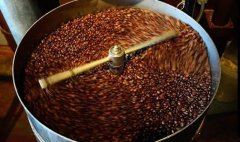Costa Rican goddess contains single bean coffee bean origin information flavor description of planting history

For professional baristas, please follow the coffee workshop (Wechat official account cafe_style)
Costa Rican coffee is produced in the Republic of Costa Rica (The Republic of Coffee) in the south of Central America. Its quality is similar to that of Colombian coffee and is suitable for blending mixed coffee. Costa Rican coffee has full particles, ideal acidity and unique strong flavor. High-quality Costa Rican coffee is called "extra hard beans". This kind of coffee can grow above 1500 meters above sea level. Altitude has always been a problem for coffee growers. The higher the altitude, the better the coffee beans, not only because the higher altitude can increase the acidity of the coffee beans and thus increase the flavor, but also because the night temperature at the higher altitude is lower, which can make the trees grow slowly, thus making the coffee beans have a stronger flavor. In addition, due to the high altitude drop caused by sufficient rainfall, is also very beneficial to the growth of coffee trees. However, while there are many advantages to growing coffee at higher elevations, the resulting additional transport costs must be taken into account, which is likely to make coffee production unprofitable. The coffee industry in Costa Rica has adopted new technologies to increase efficiency, including the use of "electric eyes" to select beans and identify coffee beans of irregular size.
Other kinds of Brazilian coffee, such as Rio and Parana, can be produced in large quantities because they do not require too much care. Although the taste is rough, it is a kind of high-quality and inexpensive coffee, which has its own standards because it is distributed all over the country and varies in quality (NO.2--NO.8 according to the number of sundries, NO.13--NO.19 according to the size of beans, and six grades according to taste). Almost all Arabica varieties are of good quality and stable in price. The most famous one is Costa Rica, which has been a necessity of blended coffee and is familiar to the public since ancient times.
Excellent Costa Rican coffee is called "extra hard beans". This kind of coffee can grow above 1500 meters above sea level. Altitude has always been a problem for coffee growers. The higher the altitude, the better the coffee beans, not only because the higher altitude can increase the acidity of the coffee beans and thus increase the flavor, but also because the night temperature at the higher altitude is lower, which can make the trees grow slowly, thus the flavor of the coffee beans is stronger. In addition, due to the high altitude drop caused by sufficient rainfall, it is very beneficial to the growth of coffee trees.
Costa Rican coffee is full of Arabica beans, washed with water, its style is bright, fragrant, clear as wind chimes swaying in the breeze, mild acidity and sweetness. Because of the sweetness, even if the coffee gets cold, it tastes very good, which is a major feature of Costa Rican coffee. Therefore, it is recommended that you taste Costa Rican coffee with only a small amount of sugar and cream in order to enjoy its girlish flavor. In 1729, coffee was introduced to Costa Rica from Cuba. Today, its coffee industry is one of the well-organized industries in the world, with an output of 1700 kilograms per hectare.
Costa Rica has only 3.5 million people but 400m coffee trees, and coffee exports account for 25 per cent of the country's total exports. Costa Rica's volcanic soil is very fertile and well drained, especially in the central plateau CentralPlateau, where the soil consists of successive layers of ash and dust. Costa Rica was therefore the first country in Central America to grow coffee and bananas for commercial value. Coffee and bananas are the country's main exports. Coffee trees grown in Costa Rica are grown in Arabica, and the quality of coffee beans is better and more stable. In order to facilitate picking, coffee trees are kept at a height of about 2 meters through continuous pruning. The coffee that people eat is the taste of the seeds in the fruit that are brewed in water. After picking raw coffee beans, you must remove the peel, pulp, seed film and sun exposure before roasting the seeds (that is, coffee beans). Part of the process can be replaced by machines, and the speed of coffee production increases a lot, but there is no machine to do it. Artificial Costa Rican coffee must be used with full particles, ideal acidity and unique strong flavor. Costa Rica's coffee industry, originally controlled by the Costa Rican Coffee Industry Company (ICAFE), has been taken over by the official Coffee Committee (Oficinale Cafe). Among the exported coffee, those products that are considered to be of substandard quality are colored with blue vegetable dyes and then transferred back to China for sale. Coffee consumed domestically (dyed blue or undyed) accounts for about 10% of total production, and local per capita coffee consumption is twice that of Italy or the United States.
This coffee producer, with all grades and types of coffee, accounts for 1/3 of the global consumption and occupies a place in the global coffee market. Although the natural disasters faced by Costa Rica are several times higher than those in other regions, but its arable area is enough to make up for it.
Costa Rican coffee has obvious acidity, acidity is strong, but not irritating and divergent, the whole mouth will be filled with this fruit-like sweet and sour aroma. The bitterness is not very obvious, but it has a beautiful return. There is no astringent taste, the overall taste is very pure and balanced, making people feel very soft. If you wait for it to taste a little cooler, the sour taste will become more obvious, and the bitter feeling will also become more intense, but the purity and balance are still so good. The producing area is still excellent at an altitude of 9-1600 meters, of which 80% is located at 1000-1400 meters. This kind of coffee is famous for its excellent quality and rich and balanced taste. Even the coffee from Laminita Farm in the region is thought to have a flavor similar to Blue Mountain coffee.
Costa Rican coffee is mostly washed, and honey-treated beans are not common. Honey treatment in Xiaoxu store inherits the balanced taste of Costa Rican coffee and brings more surprises in terms of mellowness and richness. Costa Rican coffee has a unique aroma, similar to the smell of flowers and a faint aroma of fruit, but the feeling is not muddy, but fresh and full-bodied. It seems to infiltrate the whole body through the skin, which makes Costa Rican coffee very popular with coffee customers. One of the most eye-catching is the Costa Rican Tara beads (Tarrazu) produced in the Tarazu region near the capital San Jose. The producing areas benefit from the warm and wet air flow in the Pacific Ocean and have obvious dry and wet seasons. the weakly acidic volcanic soil is rich in organic matter, which creates good conditions for the root development of coffee plants.
Costa Rica is geographically located in Central America, closer to South America, which has no army and only a small number of policemen to maintain law and order; here are the lucky few in Central America who have not experienced the hardships of war; there are tropical rain forests; there are beautiful tropical scenery; there are warm and cheerful people. Costa Rica is so special, and of course there is also the pearl of the coffee world-Costa Rican coffee was introduced by Cuba in 1729. Costa Rican coffee cultivation now has the most complete government assistance system in the world. Although Costa Rica is the second largest banana exporter in the world, coffee is the second major crop in the country's agriculture. Coffee obviously brings more benefits than bananas.
There are many kinds of coffee here, but its industrial policy is large and cheap, so there is not much premium coffee, but it is a good choice for mixing other coffees.
One of the most famous is Mountain Costa Rica Coffee, which tastes mellow and neutral. It can be boiled directly or mixed with other kinds of coffee beans into mixed coffee. It is also a good choice.
Important Notice :
前街咖啡 FrontStreet Coffee has moved to new addredd:
FrontStreet Coffee Address: 315,Donghua East Road,GuangZhou
Tel:020 38364473
- Prev

Costa Rican Goddess Manor single bean coffee bean treatment introduces the characteristics of flavor description
Exchange of professional baristas Please pay attention to the coffee workshop (Wechat official account cafe_style) excellent Costa Rican coffee known as extra-hard beans, this kind of coffee can grow above 1500 meters above sea level. Altitude has always been a problem for coffee growers. The higher the altitude, the better the coffee beans, not only because the higher altitude can increase the acidity of coffee beans and thus increase the flavor, but also
- Next

Description of the flavor of the varieties recommended for single bean cooking in Ladisha Manor
For the exchange of professional baristas, please follow the LaTisha of Guatemala made by hand in the coffee workshop (Wechat official account cafe_style). 15g powder, medium grinding (small Fuji ghost tooth cutter 4 grinding), v60 filter cup, 88-89 degrees water temperature, the first water injection 30g water, 27 seconds of steaming, injection to 105g water cut off, wait for the powder bed water to half and then water injection, slow water injection until 225g water
Related
- Does Rose Summer choose Blue, Green or Red? Detailed explanation of Rose Summer Coffee plots and Classification in Panamanian Jade Manor
- What is the difference between the origin, producing area, processing plant, cooperative and manor of coffee beans?
- How fine does the espresso powder fit? how to grind the espresso?
- Sca coffee roasting degree color card coffee roasting degree 8 roasting color values what do you mean?
- The practice of lattes: how to make lattes at home
- Introduction to Indonesian Fine Coffee beans-- Java Coffee producing area of Indonesian Arabica Coffee
- How much will the flavor of light and medium roasted rose summer be expressed? What baking level is rose summer suitable for?
- Introduction to the characteristics of washing, sun-drying or wet-planing coffee commonly used in Mantenin, Indonesia
- Price characteristics of Arabica Coffee Bean Starbucks introduction to Manning Coffee Bean Taste producing area Variety Manor
- What is the authentic Yega flavor? What are the flavor characteristics of the really excellent Yejasuffi coffee beans?

